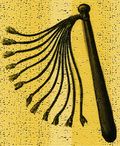Scourge
A scourge (from Italian scoriada, from Latin excoriare = "to flay" and corium = "skin") is a whip or lash, especially a multi-thong type used to inflict severe corporal punishment or self-mortification on the back.
Description
The typical scourge (Latin: flagrum; English: flagellum) has several thongs fastened to a handle; c.f. Scottish tawse (usually two or three leather thongs without a separate handle); cat o' nine tails: naval thick-rope knotted-end scourge, the army and civil prison versions usually are leather.
The scourge, or flail, and the crook, are the two symbols of power and domination depicted in the hands of Osiris in Egyptian monuments; they are the unchanging form of the instrument throughout the ages; though, the flail depicted in Egyptian mythology was an agricultural instrument used to thresh wheat, and not for corporal punishment.
From a Biblical quotation, scorpio 'scorpion' is Latin for a Roman flagrum. Hard material was affixed to multiple thongs to give a flesh-tearing 'bite' [1 Kings 12:11: ...My father scourged you with whips; I will scourge you with scorpions]. The name testifies to the pain caused by the arachnid. To its generous Roman application testitfies to the existence of the Latin words Flagrifer 'carrying a whip' and Flagritriba 'often-lashed slave'.
Scourging played a famous role as the punishment inflicted during the Passion on Jesus Christ before crucifixion, disabling him from carrying his cross to Golgotha.
Scourging was the first step in the traditional Ancient Roman punishment for parricide (Killing of one's parents).
Scourging was soon adopted as a sanction in the monastic discipline of the fifth and following centuries. Early in the fifth century it is mentioned by Palladius of Galatia in the Historia Lausiaca, tells us that, instead of being excommunicated, offending young monks were scourged. Thenceforth scourging is frequently mentioned in monastic rules and councils as a preservative of discipline. Its use as a punishment was general in the seventh century in all monasteries of the severe Columban rule.
Canon law (Decree of Gratian) recognized it as a punishment for ecclesiastics; even as late as the sixteenth and seventeenth centuries, it appears in ecclesiastical legislation as a punishment for blasphemy, concubinage and simony (paying to obtain an Churh office). Though doubtless at an early date a private means of penance and mortification, such use is publicly exemplified in the tenth and eleventh centuries by the lives of St. Dominic Loricatus and St. Peter Damian (died 1072). The latter wrote a special treatise in praise of self-flagellation; though blamed by some contemporaries for excess of zeal, his example and the high esteem in which he was held did much to popularize the voluntary use of the scourge or "discipline" as a means of mortification and penance. Thenceforth it is met with in most medieval religious orders and associations.
The practice was, of course, capable of abuse, and so arose in the thirteenth century the fanatical sect of the Flagellants, though in the same period we meet with the private use of the "discipline" by such saintly persons as King Louis IX of France and Elisabeth of Hungary.
Metaphoric use
Semi-literal usages such as "the scourge of God" for Attila, the Hun (i.e. "God's whip to punish the nations with") led to metaphoric uses to mean a severe affliction, e.g. "the scourge of drug abuse". As a result, some people forget its literal meaning and seem to imagine a connection with "scour" -to clean something by scrubbing it vigorously.
| List of Spanking Implements |
|---|
|
See "sting and thud" for more on this distinction. |
Chat rooms • What links here • Copyright info • Contact information • Category:Root
